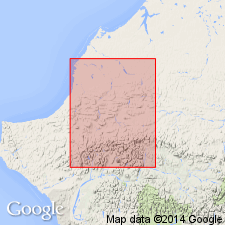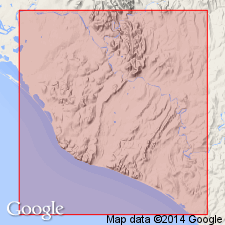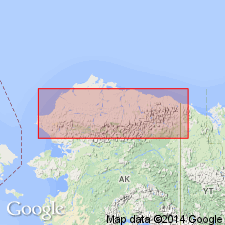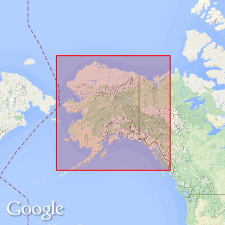
- Usage in publication:
-
- Tupik formation*
- Modifications:
-
- Named
- Biostratigraphic dating
- Dominant lithology:
-
- Limestone
- Chert
- AAPG geologic province:
-
- Alaska Northern region
Summary:
Named as uppermost formation (of 3) of Lisburne group in DeLong Mountains, Brooks Range, northern AK. Type section designated as exposures on south side of Tupik Mountain adjacent to and south of type section of Kogruk formation (new) of Lisburne group. Is predominantly dark-gray to black, finely crystalline limestone and black chert. Thickness at type is 135 ft; upper part is eroded at type; is 700 ft thick 5 mi west-southwest of type. Overlies Kogruk formation; underlies chert and shale of probable Permian age 3 mi northwest of type. Age based on sparse fauna is Late Mississippian.
Source: GNU records (USGS DDS-6; Menlo GNULEX).

- Usage in publication:
-
- Tupik Formation*
- Modifications:
-
- Areal extent
- AAPG geologic province:
-
- Alaska Northern region
Summary:
Tupik Formation of Sable and Dutro (1961) is geographically extended to vicinity of Chariot Site, Lisburne Peninsula, because of approximate faunal equivalence, general similarities in rock type, and its stratigraphic position as uppermost unit in Lisburne Group. Best exposed in sea cliffs about 1.5 mi west of mouth of Nasorak Creek. Distinguished from overlying Permian Siksikpuk Formation by darker color and slightly greater resistance to erosion. Fauna (gastropods and brachiopods) identified by J.T. Dutro, Jr. indicate Late Mississippian age. Absence of fauna of Pennsylvanian age contributes to interpretation of disconformity with overlying Siksikpuk; on other hand, no fossils have been found at higher stratigraphic position than about 150 ft below top; it is possible that Pennsylvanian Period is represented by rather thin zone of nonfossiliferous rocks.
Source: GNU records (USGS DDS-6; Menlo GNULEX).

- Usage in publication:
-
- Tupik Formation*
- Modifications:
-
- Age modified
- Biostratigraphic dating
- AAPG geologic province:
-
- Alaska Northern region
Summary:
Age is considered Late Mississippian in DeLong Mountains (western Brooks Range) based on revised megafossil zonations. Assemblages (goniatites, mollusks, brachiopods) are Chesterian in age.
Source: GNU records (USGS DDS-6; Menlo GNULEX).

- Usage in publication:
-
- Tupik Formation*
- Modifications:
-
- Age modified
- AAPG geologic province:
-
- Alaska Northern region
Summary:
Tupik Formation is Late Mississippian and Early Pennsylvanian(?) age based on fossils and stratigraphic relations. [see also Campbell (1967, USGS Prof. Paper 395, p.19)]
Source: GNU records (USGS DDS-6; Menlo GNULEX).
For more information, please contact Nancy Stamm, Geologic Names Committee Secretary.
Asterisk (*) indicates published by U.S. Geological Survey authors.
"No current usage" (†) implies that a name has been abandoned or has fallen into disuse. Former usage and, if known, replacement name given in parentheses ( ).
Slash (/) indicates name conflicts with nomenclatural guidelines (CSN, 1933; ACSN, 1961, 1970; NACSN, 1983, 2005, 2021). May be explained within brackets ([ ]).

